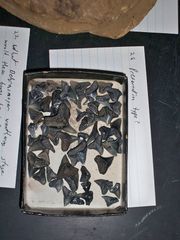Replacement
Replacement occurs when the original materials, commonly aragonite or calcite, that made up the structure of the original organism are dissolved and the remaining pore spaces are filled by new materials. This sometimes occurs on a molecular basis and the structure of the fossil is preserved. Some common replacement minerals are silica and pyrite. In oxidizing and acidic conditions silica is the most common replacement mineral, and in reducing conditions pyrite is the most common replacement mineral. Replacement is not limited to these two minerals but they are the ones most commonly observed.
The dark color shown in these fossils is a good indicator that phosphate replacement has occurred.
Another substance used in replacement is CaCO3 (Calcium Carbonate). Ground water washes into the porous organism and degrades it, leaving the minerals behind in its place. This takes many years to complete the process, but the end product yields a good internal mold.
http://www.msnucleus.org/membership/html/jh/earth/pastlife/images/clams.jpg
"Replacement of Mollusk Shells." Past Life. Web. 2 Mar 2011. <http://www.msnucleus.org/membership/html/jh/earth/pastlife/lesson2/pastlife2e.html>.
